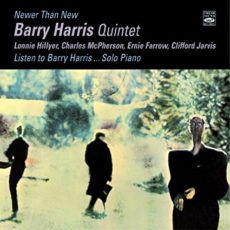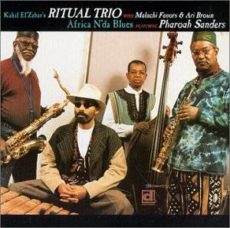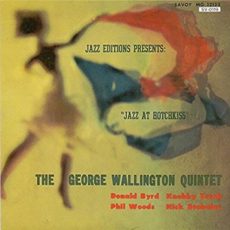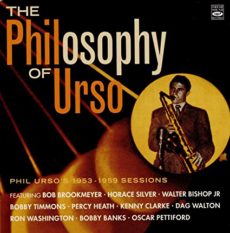
Daily Dose Of Jazz…
Ernie Farrow was born on November 13, 1928 in Huntington, West Virginia and is the half-brother to Alice Coltrane. It is said that he was responsible for introducing her to jazz. He had his own bands throughout high school and emerged in the professional jazz scene in the first half of the ’50s, working with a series of demanding bandleaders including Terry Gibbs and Stan Getz.
Farrow’s relationship with Yusef Lateef began around 1956, performing alongside Hugh Lawson and drummer Louis Hayes and recording a dozen albums with him from 1957 to 1964. Over the course of his short career he also worked with Barry Harris and John Williams among others.
A few years later he began leading his own group, based out of Detroit and was a strong influence on his younger piano-playing sister. In the ’60s he was featured on bass in a terrific classic jazz piano trio fronted by Red Garland.
Best known as a bassist, he however, started on piano before adding bass and drums. Multi-instrumentalist Ernie Farrow, who played piano, double bass, and drums, passed away on July 14, 1969.

Daily Dose Of Jazz…
Kahil El’Zabar was born on November 11, 1953 in Chicago, Illinois and attended Lake Forest College before joining the AACM, Association for the Advancement of Creative Musicians in the early 1970s. He would go on to become its chairman in 1975.
During the 1970s, he formed the musical groups Ritual Trio and the Ethnic Heritage Ensemble, both of which have remained active. Kahil has collaborated include Dizzy Gillespie, Stevie Wonder, Nina Simone, Cannonball Adderley, and Paul Simon.
The multi-instrumentalist, Kahil El’Zabar, who is mainly a percussionist and composer, regularly records for Delmark Records. As a leader and co-leader he has released eight albums, fourteen with the Ensemble, 14 with the Trio, two with the group Tri-Factor and has recorded four as a sideman with David Murray and Wadada Leo Smith. He continues to perform, compose and record.
More Posts: percussion

Daily Dose Of Jazz…
George Wallington was born Giacinto Figlia on October 27, 1924 in Palermo, Sicily and then moved to New York City with his family in 1925. His father sang opera and introduced his son to classical music, but Wallington listened to jazz after hearing the music of saxophonist Lester Young. Acquiring the name Wallington in high school by the neighborhood kids for his flashy clothes, he left school at the age of 15 to play piano in the city.
From 1943 to 1953 Wallington played with Dizzy Gillespie, Joe Marsala, Charlie Parker, Serge Chaloff, Allan Eager, Kai Winding, Terry Gibbs, Brew Moore, Al Cohn, Gerry Mulligan, Zoot Sims, and Red Rodney. He recorded as a leader for Savoy and Blue Note in 1950, toured Europe in 1953 with Lionel Hampton’s big band and in 1954-60 he led bands in New York City that contained rising musicians including Donald Byrd, Jackie McLean and Phil Woods. During this period he recorded as leader with these musicians for the Prestige and Atlantic labels.
1960 saw George leaving music and moving to Florida to work in the family air conditioning business. He cited the stress of endless touring as the reason, however, he returned to music in 1984 and recorded three albums. He also performed at the 1985 Kool Jazz Festival in New York.
Pianist and composer George Wallington, whose best-known compositions are Lemon Drop, and Godchild, passed away in Cape Coral, Miami, Florida on February 15, 1993.
More Posts: piano

Daily Dose Of Jazz…
Edgar Gómez was born October 4, 1944 in Santurce, Puerto Rico and emigrating with his family at a young age arrived in New York City, where he was raised. He started on double bass in the City’s school system at the age of eleven and at age thirteen went to the New York City High School of Music & Art. He played in the Newport Festival Youth Band, led by Marshall Brown from 1959 to 1961, and graduated from Juilliard in 1963.
Gómez has performed with Miles Davis, Dizzy Gillespie, Gerry Mulligan, John Coltrane, New York Art Quartet, Benny Goodman, Buck Clayton, Ahmad Jamal, Bill Bruford, Scott LaFaro, Marian McPartland, Paul Bley, Michael Brecker, Wayne Shorter, Steps Ahead, Steve Gadd, Ron Carter, Jeremy Steig, Herbie Hancock, Tony Williams, Al Foster, Chick Corea, Mark Kramer, Eugenio Toussaint and Carli Muñoz, just to name a few giants.
Spending a total of eleven years with the Bill Evans Trio and touring the United States, Europe and Asia, as well as recording dozens of albums, in which two of the Trio’s recordings won Grammy awards. Though Eddie was a member of the Manhattan Jazz Quintet and Steps Ahead, most of his career has been as an accompanist, a position suited for his quick reflexes and flexibility. This gave him the opportunity to record some 73 albums above and beyond his projects as a leader.
He was awarded an Honorary Doctorate of Music from Berklee College of Music in Valencia, Spain, and was the first honorary doctorate granted at the college’s new international campus. Double bassist Eddie Gómez continues to perform, record and tour.
More Posts: bass

Daily Dose Of Jazz…
Phil Urso was born on October 2, 1925 in Jersey City, New Jersey and learned clarinet as a child, but switched to tenor sax while in high school. He served in the Navy during World War II and then moved to New York City in 1947.
Once he landed in the mecca for jazz from 1948 to 1954 he played with Elliot Lawrence, Woody Herman, Terry Gibbs, Miles Davis, Oscar Pettiford , Jimmy Dorsey, and Bob Brookmeyer.
In 1955, he first began working with Chet Baker, and was a prominent contributor to Baker’s Pacific Jazz releases in 1956. Urso and Baker would collaborate sporadically for some 30 years. He also recorded with Walter Bishop Jr., Horace Silver, Percy Heath, Kenny Clarke and Bobby Timmons among others.
He went on to work with Claude Thornhill late in the 1950s, but receded from national attention in later decades. Moving to Denver, Colorado he continued performing locally into the 1990s. Tenor saxophonist Phil Urso passed away on April 7, 2008 in Denver.
More Posts: saxophone





